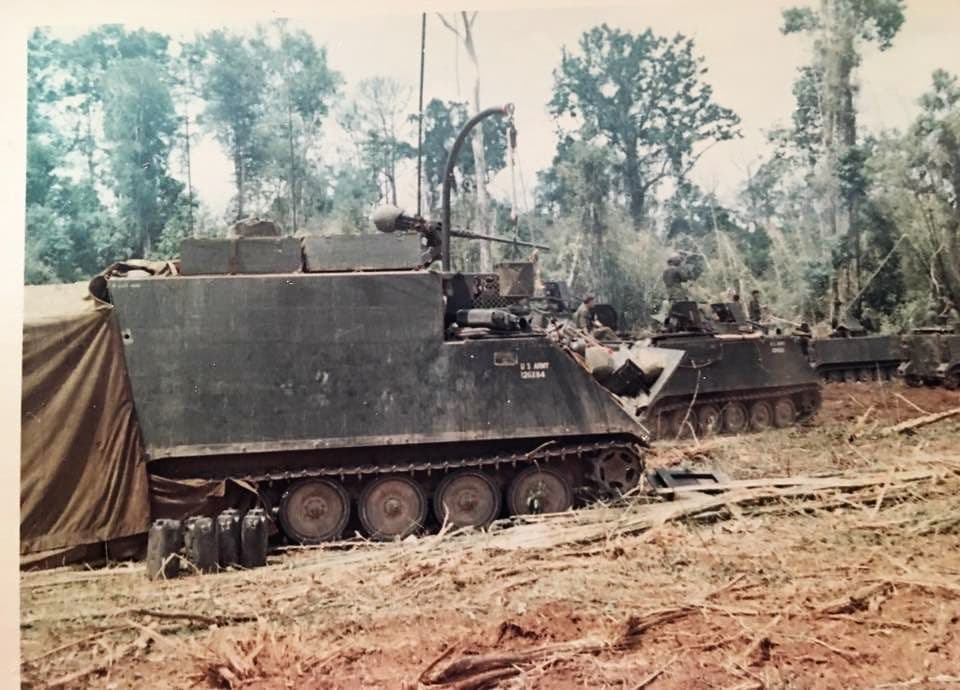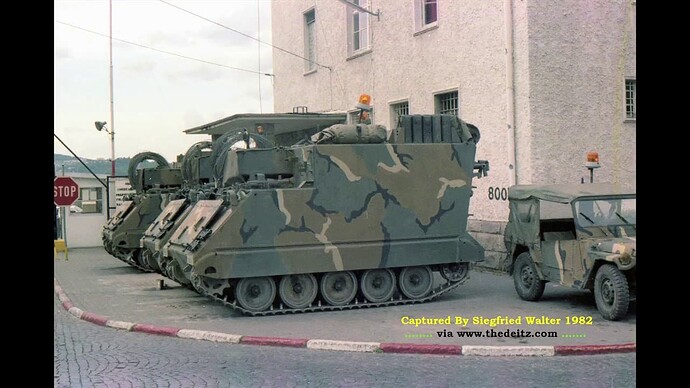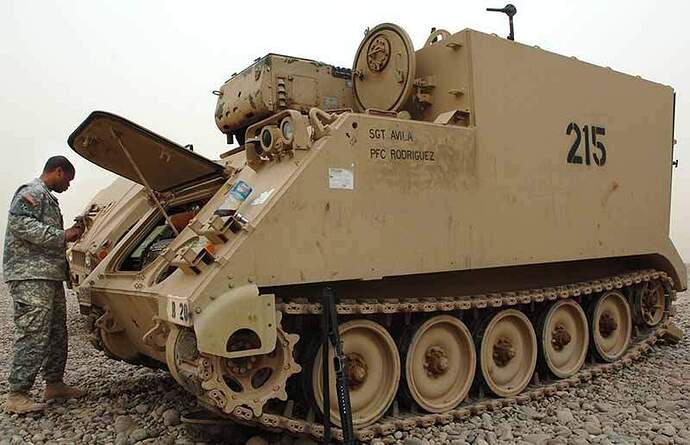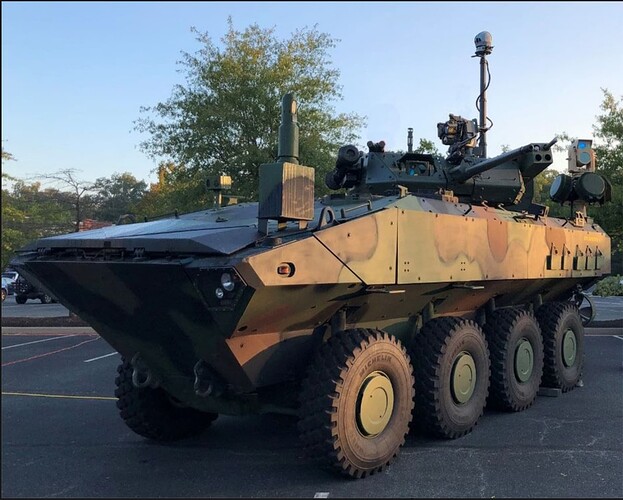Maybe the Marines are setting themselves up for the initial assault mission and not an occupation mission that breeds insurgents?
On a side-note; 14.5mm protection seems to be pretty “standard” in regards to protection levels in the wheeled afv family nowadays. Why is that ? (a simple question that raises why vehicles are armored against a caliber that they probably will never get shot with; 20/25mm is the more “common” weapon caliber used, and we begin to see a transition to 30, 35, 40 CT and even higher autocanon calibers. How can you keep up with that ? Can AP systems are even currently able to deal with that volume of incoming fire ?)
Wow! quite a discussion!
Wheeled verses tracked equipment was (and probably still is) a constant argument in the engineering and design areas. A wheeled unit will see a few advantages over a tracked unit that will jump right out in your face. They’re far cheaper for one. Tracks most often use a dedicated power pack that usually comes in at some big dollars. A wheeled unit starts out with a standard commercial power unit and gear box with some mods done to it. The LAV / Stryker units use the basic school buss drive train with an added drop box to divide the output power to four places. Really the drop box is the only oddball piece from a commercial application. You’re saving a ton of money! From the time the lady loads a raw casting for the main case on the robotic car till it’s on the shipping pallet is roughly 48 hours. (they can do it in less than 24 hours if they need to). A tracked power pack is roughly thirty days at best. Volume is so low that the costs are huge. Think of buying twenty Stryker power packs for an Abrams power pack! Spare parts are the other major issue. The Stryker can simply gets parts all over the country! Try that with a tank!
Someone spoke of fuel usage, and that was also spot on. Yet also projected to go the other way in the near future. The wheeled units actually do better off the road than most give credit for. Still not as good as tracks but for the most part will get the job done. Down time is way better with wheels than tracks.
I cannot see why the Marine Corp got out of the tank business unless they have some kind of a new scheme in the pocket. The new 40 ton tank may fit their needs better than the Abrams, but who knows.
Right now they are projecting themselves as an amphibious force trying to be a true land force. You can’t do both for sure.
gary
$$$$$. Either lack of funding… or somebody is gonna get rich on a new contract.
I don’t recall ever seeing any USMC semi-trailer tank transporters in photos as the USMC M1A1s drive on and off ships and hovercraft on their own tracks. Hence perhaps another reason why the M1A1s were ditched because in a fast-moving conflict, the tanks can’t keep up with an all-wheeled force and there are no USMC semi-trailers to haul them around.
Ironically, the USMC is tight-lipped about their new Loitering Munition trucks and AFVs. They have some prototypes, but it’s not like inventing the wheel because NATO already has SPIKE and ATGMs on IFVs and tactical trucks. The USMC has yet to put the pedal to the gas to acquire these Loitering Munition vehicles in large numbers.
Wheeled vehicles work well with firm terrain. Beyond that it will be the tracks that dominate. If you plan on fighting in a location that is firm, good to go. However we know that rain, mud, stream beds etc are a reality. If your force is confined to roadways, (like the Russians were in the Ukraine) then you have limited your combat options. With reduced options comes reduced outcomes.
Even at Guadalcanal, a typical Marine’s playing ground, a couple of tanks were very useful. Why should that change in modern conflicts?
It shouldn’t. No Marine ever said “I wish we didn’t have these tanks!”
I do not know of a fast moving situation that tracks can not keep up. Desert Storm was over in 4 days and covered a huge area. crossed the country of Kuwait. If it wasn’t for the fear of blue on blue fire slowing down the rate of march, it could have been done in 3 days. A vehicles top speed does not control the rate of march, it is the terrain, tactical situation and the logistic support available.
Here is what you need to do with wheeled vehicles in muddy terrain.
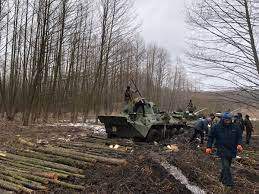
Track rescues wheels
I agree with Top (again ![]() ). Speed is not an issue; an Abrams fully combat loaded can reach 60 MPH easily.
). Speed is not an issue; an Abrams fully combat loaded can reach 60 MPH easily.
Additionally, HETS are not used to move tanks around the battlefield or so they can “keep up”. They are used to transport them behind the lines (port to assembly area, railhead to assembly area, etc…) usually to keep from adding wear and tear and saving fuel to get them forward.
leave it to the Navy and the Air Force to destroy funding in a big way. I’ve watched them do this since the mid seventies for sure. Years back the Marines wanted a new amphibious tracked piece of equipment. It was a hybrid electric drive, and pretty major in tooling cost alone. They tooled it up, and then cancelled the contract. Then settled for something less to boot. They did manage to build a small handful of prototypes that were in a constant revision, but progress was being made in rapid fashion. So what happened to all the two and a half billion dollars worth of tooling? It’s setting in plant 14 rusting away! They could have used it on the Abrams power pack, but that has pretty much dried up. Now with the new 40 ton tank coming up they’ll either have to rebuild everything (plus fixturing and tooling) or buy new stuff again! Of course the tax payer has real deep pockets! The same goes with aircraft. I’ve watched projects just keep coming out of mothballs that go on for 25+ years with no end in sight. spending money as fast as you can print it! At least wheeled equipment relies a lot on stuff already in production.
I don’t have the slightest idea what the new tank will cost upfront. The gear box is a new design concept, but also in production right now (with a lot of revisions for the use in a tank). The last time I heard the price tag on the Abrams gear box, it was $447,000! Now if you made 90 a month; the price was almost half that. A gear box for a school bus is roughly $8800 with the added cost of the drop box. So maybe $12K. They are using a commercial diesel engine. The hull is pretty much a standardized weldment, and once tooled is simple. (nothing like a tank) I doubt they have $100K in the hull complete. And probably that much in electronics as well.
If you guys sat in a meeting with money being spent like there was no end you need smelling salt! I’ve been thru more than my share of them!
gary
last time I was in Lima Ohio, I was scheduled to go for a ride on a brand new M1a1 (maybe an M1a2). It was a mid twenty degree day in Feb. Some how I got out of it, but was there when they took the tank out for it final testing. That tank with everything but ammo was clocked at 59 mph on the test track (with governors installed). Now that’s pretty damned fast for a combat ready tank! With the governor deleted you looking at 75mph! Or a very wild ride. I’ve heard that a Hemitt is just about the fastest thing on the battlefield, but also a very bad ride. What a Stryker or LAV will do I can’t say.
gary
Here is my take from a combat arms perspective. If money was the prime consideration, then just send us into war with Jeep Rubicons. As they are quickly destroyed, it’s OK because they are easy and cheap to replace. I’ve seen the commercials, they tell me that it can do everything…
Those that choose the cheap route, should have to use their design in combat for its intended purpose. I am not saying I need a rocket powered tank that can fly. I want something I believe is better than what I will be facing. Yes, common sense needs to be used in the design. Not everything needs to be custom built but when it does, so be it. I want the equipment reliable under the worst conditions, I want it private proof. It needs to be able to be repaired quickly by high school graduates. I want it viable over a 20 year period.
Here is an example of what I am saying.

Vietnam to Afghanistan, A great piece of equipment.
Woo yea! Great vehicle! Drove one in Germany for a while!
Ken
God, you don’t want much do you?
The vehicle you cite, whilst undoubtedly fit for purpose, isn’t a particularly good example i’m afraid. It has a relatively limited role and is of basic construction. What’s not to like?
With more complex equipments (and the modern battlefield is incredibly advanced and integrated) the problem comes in what can only be described as ‘Requirements Creep’ during the procurement process. Trust me, i’ve been there to see it first hand.
You have what on the face of it appears to be a straight forward customer need and if not too many people frig with it, you end up with something like the vehicle above. Problem is, what you get in the Procurement Teams is a mixture of high ranking officers (of an age shall we say), junior officers, public servants and industry moles - and they all end up fighting over what it is that the guy on the ground actually needs. Occasionaly, they may even ask the guy on the ground, but don’t count on it.
Inevitably, the requirements change, sometimes when a programme is well advanced, and long story short, procurement now takes decades in some cases and costs absolutely obscene amounts of money.
This isn’t just an American malaise I can assure you, witness the British fiascos of Chinook Mk3 Procurement & subsequent reversion (close to my heart that one as I worked on it as an FTE) and the new RN Aircraft Carriers (to catapult or not to catapult) to name but two. The Ajax programme is a good example for land based equipment.
nice thing about the M113 platform was that it was kinda modular; making it easy to upgrade. The M109 was as well (leaving out the M109a7 turd). The greatest modular platform was the Sherman tank! Probably could add the T72 tank in there as well.
Good really doesn’t mean big bucks. A good design often has a long life span
gary
Yes, correct, you summed up what I was trying to say. Thanks. ![]()
Here is a “tricked-out Industry Demonstrator” of an ACV with 30mm turret, Javelin ATGM on turret left side, APKWS rocket pod on turret right side, RADA circular radars with Anti-drone laser on top at the rear corner, FLIR sensor ball on telescopic mast, electro-optical sensor sight on turret roof, two smoke grenade launchers, and bow hull snorkel (I think).
The USMC didn’t buy this, but it does show how far the ACV can be custom-outfitted for multiple missions. The Javelin ATGM and APKWS 2.75-inch laser guided rockets can reach out to 5KM (3.1 miles) so that is further than a 120mm tank gun at 4,000 meters or 2.4 miles. One of the reasons why the USMC divested its tanks…until one has to reload the Javelin and APKWS.
A critic of the divestment said that the USMC is the only modern military that got rid of all of its tanks. No other modern military organization in the world followed the USMC.
No, but OK.
The regular ACV is in trouble after a couple rolled over in waves at Camp Pendleton in a recent excercise. Will be interesting to see how the 30mm version would fare with even more weight up high and an even less stable CoG…
IMHO theyre to tall and with no weight underneath then from tracks and running gear, so when the wheels hit bottom while hull is floating, they just become a fulcrum/pivot point and over they go.

